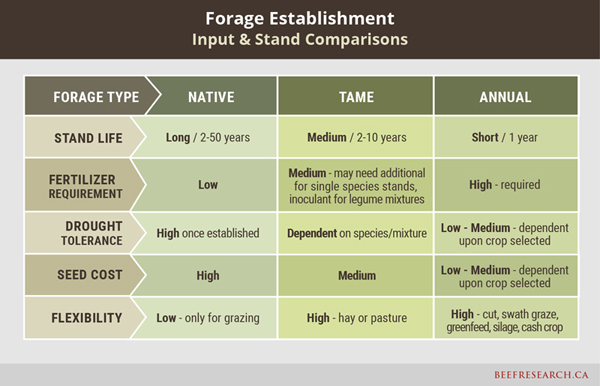Forage Establishment: New web page
Editor’s note: Relevant and up-to-date information that had been available on Foragebeef.ca is gradually being added to BeefResearch.ca. (More information). The New Forage Establishment page, which is previewed below, is one example. Further webpages will be added or updated on BeefResearch.ca to include the valuable content from Foragebeef.ca, ensuring that information remains freely available online. Completion is expected by Spring 2020.
Forage establishment is a long-term investment requiring careful planning, preparation, species selection and management to ensure success. Proper establishment of the forage stand plays a vital role in stand productivity and longevity. Begin planning at least 18 months prior to seeding forages to effectively control weeds and manage fertility.
Begin planning at least 18 months prior to seeding forages to effectively control weeds and manage fertility
Selecting the Right Forage
Land managers must carefully consider the long-term needs and goals for the forage stand and how it will function within their operation to select the appropriate species. Planning is key. Start at least 18 months prior to seeding to allow time for proper species selection, weed control, seedbed preparation, soil tests and pre-seeding fertilization. Perennial stands will usually be in production for many years, so treat it like a long-term investment. Environmental factors, intended use and stand life will impact forage species selection. Consider the land type, forage needs and utilization for the stand.
Fertility
After conducting a soil test, determine the nutrient requirements for the selected forage stands. Create a pre-seeding fertilization plan that enhances germination and establishment by correcting possible nitrogen, phosphorus, potassium and sulphur deficiencies. The fertility requirements will differ based upon the forage species as well as the soil composition and conditions. Calculate the costs and time to amend soil or correct deficiencies.
Successful Seeding
Moisture is the most important factor in successful germination and establishment of forage crops, so proper timing and weed control are vital to conserve moisture for the seedlings. In most areas, early spring seeding produces the best results because adequate moisture is usually available, and temperatures are conducive for germination. In areas with less precipitation, direct seeding into stubble is an effective way to preserve moisture to enhance germination and to provide some shelter for emerging seedlings from harsh, drying winds. Areas with excessive moisture can utilize frost seeding or later season planting to avoid soil compaction.
Forage seeds are often small and light; an ideal seedbed should be smooth, well-packed, moist and weed free to provide critical seed-to-soil contact for successful germination. Excess straw or residue on the field from prior crops can impede seed-to-soil contact and negatively impact germination. When planning 18-24 months in advance of seeding the forage crop, harvest methods in the prior years can include baling extra straw, harrowing or ensuring that the straw is well chopped and spread coming out of the combine.
Economics
The decision to establish a new forage stand requires research into species selection, timing of use, plus many other factors described above. The economics of the decision should be analyzed prior to establishment.
Costs include:
- seed
- fertilizer and crop nutrition inputs
- weed control inputs, herbicide
- equipment rental, custom seeding
- maintenance costs over life of stand (i.e. weed control, fertilization, rejuvenation)
Compare and contrast those costs with:
- days of grazing and estimated animal performance or custom pasture rental income
- market cost and estimated yield if haying and selling forage as cash crop
Learn more about forage establishment here
Click here to subscribe to the BCRC Blog and receive email notifications when new content is posted.
The sharing or reprinting of BCRC Blog articles is welcome and encouraged. Please provide acknowledgement to the Beef Cattle Research Council, list the website address, www.BeefResearch.ca, and let us know you chose to share the article by emailing us at [email protected].
We welcome your questions, comments and suggestions. Contact us directly or generate public discussion by posting your thoughts below.